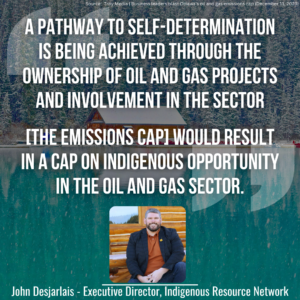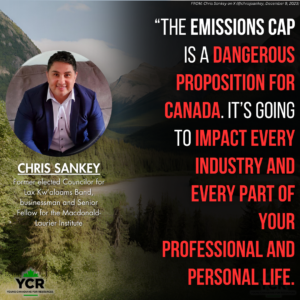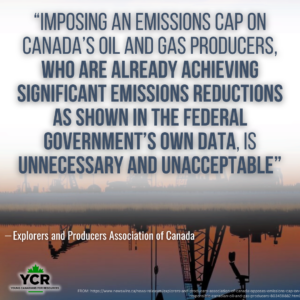Aiden Gonsalves – February 3, 2023
What the Proposed Emissions Cap Framework will mean for Canada’s 12,000+ Indigenous Oil & Gas Workers
Last December, the federal government released its plan for an emissions cap on the oil and gas sector. The plan – first proposed in a 2022 discussion paper – has been met by extensive criticism from industry advocates. Critics have been clear: the current emissions cap framework is a cap on production. The proposed emissions cap framework will hamper production of some of the world’s cleanest and most responsible oil and natural gas.
But what does the proposed emissions cap framework mean for Indigenous peoples? Specifically, how will it affect the livelihood of 12,000+ Indigenous oil and gas workers?
Indigenous Employment in the O&G Sector
Historically, Indigenous people have experienced higher unemployment rates than other Canadians. This is largely due to the devastating impacts of colonialism on the Indigenous communities that have inhabited what we now call Canada for thousands of years.
According to Statistics Canada’s most recent numbers, the Indigenous unemployment rate is 8.8%, whereas the non-Indigenous rate is 5.3%.
The effects of the Indian Act, residential schools, displacement, and other discriminatory practices have been long-recognized as leading causes of lower socio-economic outcomes experienced by many Indigenous communities.
The Truth and Reconciliation Commission of Canada’s Calls to Action report recognizes the need for both government and the corporate sector (that means businesses across all industries) to work with Indigenous communities to bridge the gap in education, training, and employment between Indigenous peoples and other Canadians.
This is where the Canadian oil and gas sector comes in.
The oil and gas sector employs more than 175,000 people from Vancouver, BC, to St. John’s, NL. On top of those directly employed within traditional oil and gas, over half a million other jobs are supported by the sector. From rig workers to pipeline engineers to accountants, the oil and gas sector puts food on the table for many families across Canada.
Around 7% of oil and gas sector workers – over 12,000 – are Indigenous. This percentage has increased in recent years and continues to climb, including within senior management roles. For comparison, Indigenous workers make up only 3.9% of the total Canadian workforce.
According to Jordan Jolicoeur, the President and CEO of Carvel Electric and a member of the Board of Directors for the Canadian Council for Aboriginal Business (CCAB), “Good paying jobs to support families, the opportunity to get training, [get] education and run a company and the ability to do this while staying close to the community you grew up in – this is what the industry brings to Indigenous people in Canada.”
On top of higher-than-average employment rates, Indigenous people also enjoy higher-than-average wages in the oil and gas sector. According to the Indigenous Resource Network (IRN), Indigenous oil and gas workers earn triple what the average Indigenous worker in Canada earns ($140,400 vs $51,120).
In the words of John Desjarlais, the IRN’s board chair, “These numbers show the resource sector is valuing the skills and experience that Indigenous workers bring to the table.”
It’s clear that the oil and gas sector provides thousands of high-paying jobs to Indigenous people in Canada. In fact, the sector provides more than simply employment: ownership opportunities, Indigenous procurement, and employment training programs are but a few of the other means through which the sector positively interacts with Indigenous communities.
The Federal Emissions Cap
Before we get into how the proposed emissions cap framework will affect more than 12,000 Indigenous workers in Canada’s oil and gas sector, what’s this emissions cap stuff all about?
Canada Action and YCR have covered the recently introduced proposed emissions cap framework extensively, so I’ll give you the TL:DR treatment here.
The proposed framework for regulating emissions in the oil and gas sector will follow a cap-and-trade model. In essence, the federal government will set a maximum level, the “cap”, that total emissions from the sector mustn’t exceed. The cap on emissions for the entire sector will decrease incrementally each year.
Oil and gas companies will then be able to buy and sell individual emissions allowances from each other – the “trade” component. For example, if Company A knows it won’t use its whole emissions quota in a given year and Company B knows it will exceed its quota, Company A can trade its remaining quota to Company B.
The cap-and-trade system will apply to upstream oil and gas activities, affecting companies involved with exploration, drilling, and extraction of crude oil and natural gas. It will also apply to liquified natural gas (LNG) facilities.
How the Emissions Cap will Affect Indigenous Peoples
The proposed emissions cap framework may sound promising in theory. After all, it’s not up for debate that the oil and gas sector – like all other sectors – needs to reduce its carbon footprint if Canada is going to reach its ambitious climate targets.
However, the proposed emissions cap framework will also jeopardize the livelihood of thousands of Indigenous workers across the sector.
How? It’s simple: by putting a cap on production. Reduced production means reduced prosperity – not just for Indigenous peoples, but for all Canadians.
The proposed framework threatens to stifle development of some of Canada’s most valuable resources: clean, responsibly produced oil and natural gas. Creating both a punishment for production and an extremely uncertain regulatory environment will severely impede the economic activity of a $100 billion industry.
The effect this will have on Indigenous oil and gas workers is aptly described by Stephen Buffalo, President and CEO of the Indian Resources Council of Canada and member of the Samson Cree First Nation, as “cutting our feet out from under us again.”
As Mr. Buffalo explains, more than 100 First Nations across Canada have invested in getting community members trained, employed, and involved with the oil and gas sector. The proposed emissions cap framework will halt, if not reverse, that progress. Mr. Buffalo has further stated “This is happening as Indigenous engagement, employment and equity investment is growing and at a time when our communities have had their first taste of real and sustainable prosperity since the newcomers killed off all the buffalo.”
In addition to curtailing Indigenous employment, the proposed emissions cap framework will also put opportunities for procurement and equity in projects at risk. “Oil and gas sector emissions caps proposed by Ottawa will hurt hundreds of Indigenous communities who need responsible resource development to achieve prosperity and opportunity,” says Chris Sankey, a member of the Coast Tsimshian community of Lax Kw’Alaams and President and CEO of Blackfish Enterprises.
Industry experts and Indigenous business leaders are explicitly clear: the proposed emissions cap framework will hurt Indigenous workers, businesses, and communities.
A Silver Lining?
So far, I’ve described a negative outlook for the oil and gas sector as it concerns its more than 12,000 Indigenous oil and gas workers. But, while the proposed emissions cap framework is bad news for many Indigenous workers, there is some reason to be hopeful.
Here are 3 reasons to be optimistic amidst the production-stifling proposed emissions cap framework:
1. The sector is already making massive strides towards reducing emissions
The emissions cap purports to force oil and gas companies into reducing emissions and producing more sustainably. In reality, the sector is already reducing emissions, without the need for a cap-and-trade system.
The Pathways Alliance, for example, is an organization comprised of 6 large energy companies that, together, account for 95% of Canada’s oil sands production. The organization is currently working on more than 70 projects aimed at reducing sector emissions. These projects focus on carbon capture and storage (CCS), a practice that significantly reduces the carbon footprint of natural resource extraction.
Outside of the Pathways Alliance, efforts to reduce emissions are increasing across the sector. The Alberta Energy Regulator (AER), for example, has been working with the Alberta government to gradually reduce the oil and gas sector’s methane emissions. The AER plays a central role in ensuring companies adhere to strict emissions reduction goals.
To learn more about what the sector is doing to reduce emissions and ensure Canada is a leader in sustainable energy production, click here.
2. LNG projects will bring prosperity to BC Indigenous communities
As previously mentioned, the cap-and-trade model for emissions will apply to LNG facilities. The good news is that Canada’s LNG efforts are set to produce some of the world’s cleanest energy.
Despite regulatory challenges, LNG activity – including export – is slowly beginning to get started in western Canada.
Projects like LNG Canada – an LNG export facility nearing completion in Kitimat, BC – bring substantial benefits to proximal Indigenous communities by way of employment, procurement, and benefit-sharing agreements. LNG Canada is being built on the traditional territories of the Haisla Nation, who are benefiting from hundreds of jobs and lucrative business opportunities.
The pipeline being built to transport natural gas from production sites to the LNG Canada facility – called the Coastal GasLink project – also supports Indigenous communities. In fact, all 20 First Nations along the pipeline route have signed benefit agreements, ensuring that prosperity within the oil and gas sector means prosperity for Indigenous peoples.
With multiple projects in the works, LNG development and export paints a positive picture for the future of Indigenous communities involved with Canada’s oil and gas sector.
3. There’s still time to oppose the emissions cap
According to Norton Rose Fulbright, the federal government is seeking input into the emissions cap framework to help inform development of the draft regulations, which it intends to publish in mid-2024. The framework will be phased in between 2026 and 2030.

Following the government’s release of the proposed framework last December, organizations like the Canadian Association of Petroleum Producers (CAPP) and the Explorers and Producers Association of Canada (EPAC) have re-affirmed their strong opposition to the cap.
Advocating on behalf of Indigenous peoples, the IRN continues to meet with decision-makers in Ottawa to discuss the adverse effects the emissions cap will have on Indigenous communities across Canada.
On top of that, the governments of Alberta and Saskatchewan have also recently issued statements of opposition to the emissions cap. Saskatchewan Premier Scott Moe calls the cap a “burden” on Canadian families.
The proposed emissions cap framework will hurt 12,000+ Indigenous oil and gas workers, as well as over 100 communities that benefit from resource extraction. While we all know that Canada must lower its emissions, we also need to consider the benefits of oil and gas production.
If you, like me, oppose the proposed emissions cap framework but still want to see emissions lowered across all sectors in Canada, there’s still time to voice opposition to the federal government. Formal written responses to the proposed emissions cap framework are to be submitted by February 5th, 2024.
Check out YCR’s work – including this petition – to stay informed and involved.
Disclaimer
Thank you for taking the time to read my work. I reside on the traditional territories of the people of the Treaty 7 region in Southern Alberta, and respectfully acknowledge my presence as a settler on these lands.
Please note that “Indigenous communities”, “Indigenous people”, and other similar terms are used throughout this article. I respectfully acknowledge that Indigenous peoples in Canada – whether First Nations, Inuit, or Metis – are not a monolith. The hundreds of Indigenous communities across Canada have distinct cultures, heritages, and beliefs. Most importantly, each Indigenous community has a unique perspective on resource development. The views expressed in this article are strictly my own.
